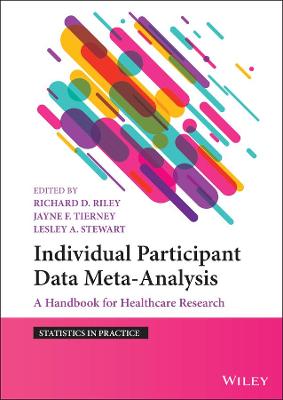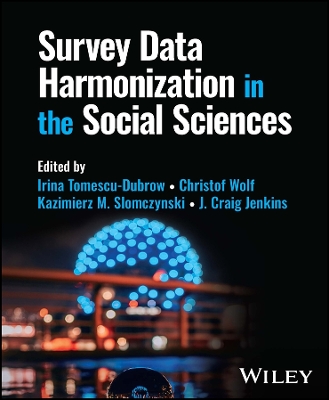Individual Participant Data Meta-Analysis
 -15%
portes grátis
-15%
portes grátis
Individual Participant Data Meta-Analysis
A Handbook for Healthcare Research
Stewart, Lesley A.; Tierney, Jayne F.; Riley, Richard D.
John Wiley & Sons Inc
06/2021
560
Dura
Inglês
9781119333722
15 a 20 dias
1216
1 Individual Participant Data Meta-analysis for Healthcare Research 1
Richard D. Riley, Lesley A. Stewart, and Jayne F. Tierney
1.1 Introduction 1
1.2 What Is IPD and How Does It Differ from Aggregate Data? 1
1.3 IPD Meta-analysis: A New Era for Evidence Synthesis 2
1.4 Scope of This Book and Intended Audience 2
Part I Rationale, Planning, and Conduct 7
2 Rationale for Embarking on an IPD Meta-analysis Project 9
Jayne F. Tierney, Richard D. Riley, Catrin Tudur Smith, Mike Clarke, and Lesley A. Stewart
2.1 Introduction 9
2.2 How Does the Research Process Differ for IPD and Aggregate Data Meta-analysis Projects? 10
2.3 What Are the Potential Advantages of an IPD Meta-analysis Project? 11
2.4 What Are the Potential Challenges of an IPD Meta-Analysis Project? 14
2.5 Empirical Evidence of Differences between Results of IPD and Aggregate Data Metaanalysis Projects 14
2.6 Guidance for Deciding When IPD Meta-analysis Projects Are Needed to Evaluate Treatment Effects from Randomised Trials 15
2.7 Concluding Remarks 19
3 Planning and Initiating an IPD Meta-analysis Project 21
Lesley A. Stewart, Richard D. Riley, and Jayne F. Tierney
3.1 Introduction 22
3.2 Organisational Approach 22
3.3 Developing a Project Scope 26
3.4 Assessing Feasibility and 'In Principle' Support and Collaboration 26
3.5 Establishing a Team with the Right Skills 29
3.6 Advisory and Governance Functions 30
3.7 Estimating How Long the Project Will Take 31
3.8 Estimating the Resources Required 33
3.9 Obtaining Funding 38
3.10 Obtaining Ethical Approval 39
3.11 Data-sharing Agreement 41
3.12 Additional Planning for Prospective Meta-analysis Projects 41
3.13 Concluding Remarks 43
4 Running an IPD Meta-analysis Project: From Developing the Protocol to Preparing Data for Meta-analysis 45
Jayne F. Tierney, Richard D. Riley, Larysa H.M. Rydzewska, and Lesley A. Stewart
4.1 Introduction 46
4.2 Preparing to Collect IPD 46
4.3 Initiating and Maintaining Collaboration 57
4.4 Obtaining IPD 59
4.5 Checking and Harmonising Incoming IPD 62
4.6 Checking the IPD to Inform Risk of Bias Assessments 66
4.7 Assessing and Presenting the Overall Quality of a Trial 76
4.8 Verification of Finalised Trial IPD 77
4.9 Merging IPD Ready for Meta-analysis 77
4.10 Concluding Remarks 80
Part I References 81
Part II Fundamental Statistical Methods and Principles 87
5 The Two-stage Approach to IPD Meta-analysis 89
Richard D. Riley, Thomas P.A. Debray, Tim P. Morris, and Dan Jackson
5.1 Introduction 90
5.2 First Stage of a Two-stage IPD Meta-analysis 90
5.3 Second Stage of a Two-stage IPD Meta-analysis 106
5.4 Meta-regression and Subgroup Analyses 120
5.5 The ipdmetan Software Package 121
5.6 Combining IPD with Aggregate Data from non-IPD Trials 124
5.7 Concluding Remarks 125
6 The One-stage Approach to IPD Meta-analysis 127
Richard D. Riley and Thomas P.A. Debray 127
6.1 Introduction 128
6.2 One-stage IPD Meta-analysis Models Using Generalised Linear Mixed Models 129
6.3 One-stage Models for Time-to-event Outcomes 152
6.4 One-stage Models Combining Different Sources of Evidence 159
6.5 Reporting of One-stage Models in Protocols and Publications 162
6.6 Concluding Remarks 162
7 Using IPD Meta-analysis to Examine Interactions between Treatment Effect and Participant-level Covariates 163
Richard D. Riley and David J. Fisher
7.1 Introduction 164
7.2 Meta-regression and Its Limitations 166
7.3 Two-stage IPD Meta-analysis to Estimate Treatment-covariate Interactions 168
7.4 The One-stage Approach 174
7.5 Combining IPD and non-IPD Trials 181
7.6 Handling of Continuous Covariates 184
7.7 Handling of Categorical or Ordinal Covariates 191
7.8 Misconceptions and Cautions 191
7.9 Is My Identified Treatment-covariate Interaction Genuine? 195
7.10 Reporting of Analyses of Treatment-covariate Interactions 196
7.11 Can We Predict a New Patient's Treatment Effect? 196
7.11.1 Linking Predictions to Clinical Decision Making 198
7.12 Concluding Remarks 198
8 One-stage versus Two-stage Approach to IPD Meta-analysis: Differences and Recommendations 199
Richard D. Riley, Danielle L. Burke, and Tim Morris
8.1 Introduction 200
8.2 One-stage and Two-stage Approaches Usually Give Similar Results 200
8.3 Ten Key Reasons Why One-stage and Two-stage Approaches May Give Different Results 203
8.4 Recommendations and Guidance 216
8.5 Concluding Remarks 217
Part II References 219
Part III Critical Appraisal and Dissemination 237
9 Examining the Potential for Bias in IPD Meta-analysis Results 239
Richard D. Riley, Jayne F. Tierney, and Lesley A. Stewart
9.1 Introduction 240
9.2 Publication and Reporting Biases of Trials 240
9.3 Biased Availability of the IPD from Trials 244
9.4 Trial Quality (risk of bias) 247
9.5 Other Potential Biases Affecting IPD Meta-analysis Results 248
9.6 Concluding Remarks 251
10 Reporting and Dissemination of IPD Meta-analyses 253
Lesley A. Stewart, Richard D. Riley, and Jayne F. Tierney
10.1 Introduction 253
10.2 Reporting IPD Meta-analysis Projects in Academic Reports 254
10.3 Additional Means of Disseminating Findings 266
10.4 Concluding Remarks 270
11 A Tool for the Critical Appraisal of IPD Meta-analysis Projects (CheckMAP) 271
Jayne F. Tierney, Lesley A. Stewart, Claire L. Vale, and Richard D. Riley
11.1 Introduction 271
11.2 The CheckMAP Tool 272
11.3 Was the IPD Meta-analysis Project Done within a Systematic Review Framework? 272
11.4 Were the IPD Meta-analysis Project Methods Pre-specified in a Publicly Available Protocol? 274
11.5 Did the IPD Meta-analysis Project Have a Clear Research Question Qualified by Explicit Eligibility Criteria? 276
11.6 Did the IPD Meta-analysis Project Have a Systematic and Comprehensive Search Strategy? 276
11.7 Was the Approach to Data Collection Consistent and Thorough? 277
11.8 Were IPD Obtained from Most Eligible Trials and Their Participants? 277
11.9 Was the Validity of the IPD Checked for Each Trial? 278
11.10 Was the Risk of Bias Assessed for Each Trial and Its Associated IPD? 27811.10.1 Was the Randomisation Process Checked Based on IPD? 278
11.11 Were the Methods of Meta-analysis Appropriate? 280
11.12 Concluding Remarks 283
Part III References 285
Part IV Special Topics in Statistics 291
12 Power Calculations for Planning an IPD Meta-analysis 293
Richard D. Riley and Joie Ensor
12.1 Introduction 294
12.2 Motivating Example: Power of a Planned IPD Meta-analysis of Trials of Interventions to Reduce Weight Gain in Pregnant Women 295
12.3 The Contribution of Individual Trials Toward Power 301
12.4 The Impact of Model Assumptions on Power 302
12.5 Extensions 305
12.6 Concluding Remarks 309
13 Multivariate Meta-analysis Using IPD 311
Richard D. Riley, Dan Jackson, and Ian R. White
13.1 Introduction 312
13.2 General Two-stage Approach for Multivariate IPD Meta-analysis 314
13.3 Application to an IPD Meta-analysis of Anti-hypertensive Trials 329
13.4 Extension to Multivariate Meta-regression 333
13.5 Potential Limitations of Multivariate Meta-analysis 334
13.6 One-stage Multivariate IPD Meta-analysis Applications 337
13.7 Special Applications of Multivariate Meta-analysis 340
13.8 Concluding Remarks 346
14 Network Meta-analysis Using IPD 347
Richard D. Riley, David M. Phillippo, and Sofia Dias
14.1 Introduction 348
14.2 Rationale and Assumptions for Network Meta-analysis 348
14.3 Network Meta-analysis Models Assuming Consistency 350
14.4 Ranking Treatments 357
14.5 How Do We Examine Inconsistency between Direct and Indirect Evidence? 359
14.6 Benefits of IPD for Network Meta-analysis 361
14.7 Combining IPD and Aggregate Data in Network Meta-analysis 365
14.8 Further Topics 370
14.9 Concluding Remarks 372
Part IV References 375
Part V Diagnosis, Prognosis and Prediction 387
15 IPD Meta-analysis for Test Accuracy Research 389
Richard D. Riley, Brooke Levis, and Yemisi Takwoingi 389
15.1 Introduction 390
15.2 Motivating Example: Diagnosis of Fever in Children Using Ear Temperature 394
15.3 Key Steps Involved in an IPD Meta-analysis of Test Accuracy Studies 397
15.4 IPD Meta-analysis of Test Accuracy at Multiple Thresholds 410
15.5 IPD Meta-analysis for Examining a Test's Clinical Utility 414
15.6 Comparing Tests 418
15.7 Concluding Remarks 420
16 IPD Meta-analysis for Prognostic Factor Research 421
Richard D. Riley, Karel G.M. Moons, and Thomas P.A. Debray
16.1 Introduction 422
16.2 Potential Advantages of an IPD Meta-analysis 424
16.3 Key Steps Involved in an IPD Meta-analysis of Prognostic Factor Studies 427
16.4 Software 444
16.5 Concluding Remarks 444
17 IPD Meta-analysis for Clinical Prediction Model Research 447
Richard D. Riley, Kym I.E. Snell, Laure Wynants, Valentijn M.T. de Jong, Karel G.M. Moons, and Thomas P.A. Debray
17.1 Introduction 448
17.2 IPD Meta-analysis for Prediction Model Research 448
17.3 External Validation of an Existing Prediction Model Using IPD Meta-analysis 455
17.4 Updating and Tailoring of a Prediction Model Using IPD Meta-analysis 470
17.5 Comparison of Multiple Existing Prediction Models Using IPD Meta-analysis 472
17.6 Using IPD Meta-analysis to Examine the Added Value of a New Predictor to an Existing Prediction Model 478
17.7 Developing a New Prediction Model Using IPD Meta-analysis 479
17.8 Examining the Utility of a Prediction Model Using IPD Meta-analysis 491
17.9 Software 494
17.10 Reporting 495
17.11 Concluding Remarks 495
18 Dealing with Missing Data in an IPD Meta-analysis 499
Thomas Debray, Kym I.E. Snell, Matteo Quartagno, Shahab Jolani, Karel G.M. Moons, and Richard D. Riley 499
18.1 Introduction 500
18.2 Motivating Example: IPD Meta-analysis Validating Prediction Models for Risk of Preeclampsia in Pregnancy 500
18.3 Types of Missing Data in an IPD Meta-analysis 502
18.4 Recovering Actual Values of Missing Data within IPD 502
18.5 Mechanisms and Patterns of Missing Data in an IPD Meta-analysis 502
18.6 Multiple Imputation to Deal with Missing Data in a Single Study 506
18.7 Ensuring Congeniality of Imputation and Analysis Models 509
18.8 Dealing with Sporadically Missing Data in an IPD Meta-analysis by Applying Multiple Imputation for Each Study Separately 509
18.9 Dealing with Systematically Missing Data in an IPD Meta-analysis Using a Bivariate Metaanalysis of Partially and Fully Adjusted Results 511
18.10 Dealing with Both Sporadically and Systematically Missing Data in an IPD Meta-analysis Using Multilevel Modelling 514
18.11 Comparison of Methods and Recommendations 521
18.12 Software 523
18.13 Concluding Remarks 524
Part V References 525
Index 000
1 Individual Participant Data Meta-analysis for Healthcare Research 1
Richard D. Riley, Lesley A. Stewart, and Jayne F. Tierney
1.1 Introduction 1
1.2 What Is IPD and How Does It Differ from Aggregate Data? 1
1.3 IPD Meta-analysis: A New Era for Evidence Synthesis 2
1.4 Scope of This Book and Intended Audience 2
Part I Rationale, Planning, and Conduct 7
2 Rationale for Embarking on an IPD Meta-analysis Project 9
Jayne F. Tierney, Richard D. Riley, Catrin Tudur Smith, Mike Clarke, and Lesley A. Stewart
2.1 Introduction 9
2.2 How Does the Research Process Differ for IPD and Aggregate Data Meta-analysis Projects? 10
2.3 What Are the Potential Advantages of an IPD Meta-analysis Project? 11
2.4 What Are the Potential Challenges of an IPD Meta-Analysis Project? 14
2.5 Empirical Evidence of Differences between Results of IPD and Aggregate Data Metaanalysis Projects 14
2.6 Guidance for Deciding When IPD Meta-analysis Projects Are Needed to Evaluate Treatment Effects from Randomised Trials 15
2.7 Concluding Remarks 19
3 Planning and Initiating an IPD Meta-analysis Project 21
Lesley A. Stewart, Richard D. Riley, and Jayne F. Tierney
3.1 Introduction 22
3.2 Organisational Approach 22
3.3 Developing a Project Scope 26
3.4 Assessing Feasibility and 'In Principle' Support and Collaboration 26
3.5 Establishing a Team with the Right Skills 29
3.6 Advisory and Governance Functions 30
3.7 Estimating How Long the Project Will Take 31
3.8 Estimating the Resources Required 33
3.9 Obtaining Funding 38
3.10 Obtaining Ethical Approval 39
3.11 Data-sharing Agreement 41
3.12 Additional Planning for Prospective Meta-analysis Projects 41
3.13 Concluding Remarks 43
4 Running an IPD Meta-analysis Project: From Developing the Protocol to Preparing Data for Meta-analysis 45
Jayne F. Tierney, Richard D. Riley, Larysa H.M. Rydzewska, and Lesley A. Stewart
4.1 Introduction 46
4.2 Preparing to Collect IPD 46
4.3 Initiating and Maintaining Collaboration 57
4.4 Obtaining IPD 59
4.5 Checking and Harmonising Incoming IPD 62
4.6 Checking the IPD to Inform Risk of Bias Assessments 66
4.7 Assessing and Presenting the Overall Quality of a Trial 76
4.8 Verification of Finalised Trial IPD 77
4.9 Merging IPD Ready for Meta-analysis 77
4.10 Concluding Remarks 80
Part I References 81
Part II Fundamental Statistical Methods and Principles 87
5 The Two-stage Approach to IPD Meta-analysis 89
Richard D. Riley, Thomas P.A. Debray, Tim P. Morris, and Dan Jackson
5.1 Introduction 90
5.2 First Stage of a Two-stage IPD Meta-analysis 90
5.3 Second Stage of a Two-stage IPD Meta-analysis 106
5.4 Meta-regression and Subgroup Analyses 120
5.5 The ipdmetan Software Package 121
5.6 Combining IPD with Aggregate Data from non-IPD Trials 124
5.7 Concluding Remarks 125
6 The One-stage Approach to IPD Meta-analysis 127
Richard D. Riley and Thomas P.A. Debray 127
6.1 Introduction 128
6.2 One-stage IPD Meta-analysis Models Using Generalised Linear Mixed Models 129
6.3 One-stage Models for Time-to-event Outcomes 152
6.4 One-stage Models Combining Different Sources of Evidence 159
6.5 Reporting of One-stage Models in Protocols and Publications 162
6.6 Concluding Remarks 162
7 Using IPD Meta-analysis to Examine Interactions between Treatment Effect and Participant-level Covariates 163
Richard D. Riley and David J. Fisher
7.1 Introduction 164
7.2 Meta-regression and Its Limitations 166
7.3 Two-stage IPD Meta-analysis to Estimate Treatment-covariate Interactions 168
7.4 The One-stage Approach 174
7.5 Combining IPD and non-IPD Trials 181
7.6 Handling of Continuous Covariates 184
7.7 Handling of Categorical or Ordinal Covariates 191
7.8 Misconceptions and Cautions 191
7.9 Is My Identified Treatment-covariate Interaction Genuine? 195
7.10 Reporting of Analyses of Treatment-covariate Interactions 196
7.11 Can We Predict a New Patient's Treatment Effect? 196
7.11.1 Linking Predictions to Clinical Decision Making 198
7.12 Concluding Remarks 198
8 One-stage versus Two-stage Approach to IPD Meta-analysis: Differences and Recommendations 199
Richard D. Riley, Danielle L. Burke, and Tim Morris
8.1 Introduction 200
8.2 One-stage and Two-stage Approaches Usually Give Similar Results 200
8.3 Ten Key Reasons Why One-stage and Two-stage Approaches May Give Different Results 203
8.4 Recommendations and Guidance 216
8.5 Concluding Remarks 217
Part II References 219
Part III Critical Appraisal and Dissemination 237
9 Examining the Potential for Bias in IPD Meta-analysis Results 239
Richard D. Riley, Jayne F. Tierney, and Lesley A. Stewart
9.1 Introduction 240
9.2 Publication and Reporting Biases of Trials 240
9.3 Biased Availability of the IPD from Trials 244
9.4 Trial Quality (risk of bias) 247
9.5 Other Potential Biases Affecting IPD Meta-analysis Results 248
9.6 Concluding Remarks 251
10 Reporting and Dissemination of IPD Meta-analyses 253
Lesley A. Stewart, Richard D. Riley, and Jayne F. Tierney
10.1 Introduction 253
10.2 Reporting IPD Meta-analysis Projects in Academic Reports 254
10.3 Additional Means of Disseminating Findings 266
10.4 Concluding Remarks 270
11 A Tool for the Critical Appraisal of IPD Meta-analysis Projects (CheckMAP) 271
Jayne F. Tierney, Lesley A. Stewart, Claire L. Vale, and Richard D. Riley
11.1 Introduction 271
11.2 The CheckMAP Tool 272
11.3 Was the IPD Meta-analysis Project Done within a Systematic Review Framework? 272
11.4 Were the IPD Meta-analysis Project Methods Pre-specified in a Publicly Available Protocol? 274
11.5 Did the IPD Meta-analysis Project Have a Clear Research Question Qualified by Explicit Eligibility Criteria? 276
11.6 Did the IPD Meta-analysis Project Have a Systematic and Comprehensive Search Strategy? 276
11.7 Was the Approach to Data Collection Consistent and Thorough? 277
11.8 Were IPD Obtained from Most Eligible Trials and Their Participants? 277
11.9 Was the Validity of the IPD Checked for Each Trial? 278
11.10 Was the Risk of Bias Assessed for Each Trial and Its Associated IPD? 27811.10.1 Was the Randomisation Process Checked Based on IPD? 278
11.11 Were the Methods of Meta-analysis Appropriate? 280
11.12 Concluding Remarks 283
Part III References 285
Part IV Special Topics in Statistics 291
12 Power Calculations for Planning an IPD Meta-analysis 293
Richard D. Riley and Joie Ensor
12.1 Introduction 294
12.2 Motivating Example: Power of a Planned IPD Meta-analysis of Trials of Interventions to Reduce Weight Gain in Pregnant Women 295
12.3 The Contribution of Individual Trials Toward Power 301
12.4 The Impact of Model Assumptions on Power 302
12.5 Extensions 305
12.6 Concluding Remarks 309
13 Multivariate Meta-analysis Using IPD 311
Richard D. Riley, Dan Jackson, and Ian R. White
13.1 Introduction 312
13.2 General Two-stage Approach for Multivariate IPD Meta-analysis 314
13.3 Application to an IPD Meta-analysis of Anti-hypertensive Trials 329
13.4 Extension to Multivariate Meta-regression 333
13.5 Potential Limitations of Multivariate Meta-analysis 334
13.6 One-stage Multivariate IPD Meta-analysis Applications 337
13.7 Special Applications of Multivariate Meta-analysis 340
13.8 Concluding Remarks 346
14 Network Meta-analysis Using IPD 347
Richard D. Riley, David M. Phillippo, and Sofia Dias
14.1 Introduction 348
14.2 Rationale and Assumptions for Network Meta-analysis 348
14.3 Network Meta-analysis Models Assuming Consistency 350
14.4 Ranking Treatments 357
14.5 How Do We Examine Inconsistency between Direct and Indirect Evidence? 359
14.6 Benefits of IPD for Network Meta-analysis 361
14.7 Combining IPD and Aggregate Data in Network Meta-analysis 365
14.8 Further Topics 370
14.9 Concluding Remarks 372
Part IV References 375
Part V Diagnosis, Prognosis and Prediction 387
15 IPD Meta-analysis for Test Accuracy Research 389
Richard D. Riley, Brooke Levis, and Yemisi Takwoingi 389
15.1 Introduction 390
15.2 Motivating Example: Diagnosis of Fever in Children Using Ear Temperature 394
15.3 Key Steps Involved in an IPD Meta-analysis of Test Accuracy Studies 397
15.4 IPD Meta-analysis of Test Accuracy at Multiple Thresholds 410
15.5 IPD Meta-analysis for Examining a Test's Clinical Utility 414
15.6 Comparing Tests 418
15.7 Concluding Remarks 420
16 IPD Meta-analysis for Prognostic Factor Research 421
Richard D. Riley, Karel G.M. Moons, and Thomas P.A. Debray
16.1 Introduction 422
16.2 Potential Advantages of an IPD Meta-analysis 424
16.3 Key Steps Involved in an IPD Meta-analysis of Prognostic Factor Studies 427
16.4 Software 444
16.5 Concluding Remarks 444
17 IPD Meta-analysis for Clinical Prediction Model Research 447
Richard D. Riley, Kym I.E. Snell, Laure Wynants, Valentijn M.T. de Jong, Karel G.M. Moons, and Thomas P.A. Debray
17.1 Introduction 448
17.2 IPD Meta-analysis for Prediction Model Research 448
17.3 External Validation of an Existing Prediction Model Using IPD Meta-analysis 455
17.4 Updating and Tailoring of a Prediction Model Using IPD Meta-analysis 470
17.5 Comparison of Multiple Existing Prediction Models Using IPD Meta-analysis 472
17.6 Using IPD Meta-analysis to Examine the Added Value of a New Predictor to an Existing Prediction Model 478
17.7 Developing a New Prediction Model Using IPD Meta-analysis 479
17.8 Examining the Utility of a Prediction Model Using IPD Meta-analysis 491
17.9 Software 494
17.10 Reporting 495
17.11 Concluding Remarks 495
18 Dealing with Missing Data in an IPD Meta-analysis 499
Thomas Debray, Kym I.E. Snell, Matteo Quartagno, Shahab Jolani, Karel G.M. Moons, and Richard D. Riley 499
18.1 Introduction 500
18.2 Motivating Example: IPD Meta-analysis Validating Prediction Models for Risk of Preeclampsia in Pregnancy 500
18.3 Types of Missing Data in an IPD Meta-analysis 502
18.4 Recovering Actual Values of Missing Data within IPD 502
18.5 Mechanisms and Patterns of Missing Data in an IPD Meta-analysis 502
18.6 Multiple Imputation to Deal with Missing Data in a Single Study 506
18.7 Ensuring Congeniality of Imputation and Analysis Models 509
18.8 Dealing with Sporadically Missing Data in an IPD Meta-analysis by Applying Multiple Imputation for Each Study Separately 509
18.9 Dealing with Systematically Missing Data in an IPD Meta-analysis Using a Bivariate Metaanalysis of Partially and Fully Adjusted Results 511
18.10 Dealing with Both Sporadically and Systematically Missing Data in an IPD Meta-analysis Using Multilevel Modelling 514
18.11 Comparison of Methods and Recommendations 521
18.12 Software 523
18.13 Concluding Remarks 524
Part V References 525
Index 000















